Novel High Step-Up DC–DC Converter with Three-Winding-Coupled-Inductors and Its Derivatives for a Distributed Generation System
Abstract
1. Introduction
2. Proposed High Step-Up Converter and Corresponding Operating Principles
- (1)
- The capacitors in this converter are large enough that the voltages of those capacitors can be considered constant in one period.
- (2)
- Switches and diodes are considered as ideal, and will not be discussed in transient states.
- (3)
- The coupled inductor’s coupling coefficient K is equal to LM/(LM + LK).
3. Steady-State Analysis
3.1. Analysis in Continuous Conduction Mode
3.2. Voltage Stress Analysis
4. Derivative Converters
5. Experimental Verifications
6. Conclusions
- (1)
- It utilized smaller turns ratios, and can therefore achieve a higher voltage conversion gain in a normal small duty cycle;
- (2)
- A reduced magnetic size can be applied in this converter to achieve high voltage gain. It is suitable for DG system based on distributed generation system;
- (3)
- Two diodes avoid the reverse-recovery problem by achieving turn-off naturally;
- (4)
- The presented converter can recycle the leakage inductance energy to improve performance.
- (5)
- The voltage stress of the output capacitor is reduced.
Author Contributions
Funding
Conflicts of Interest
Nomenclature
| LM | Magnetizing inductance |
| LK | Leakage inductance |
| , , , | Voltages of magnetizing inductances in model I, II, III and IV |
| , , , | Voltages of leakage inductors in model I, II, III and IV |
| Vin | Input DC voltage |
| N1, N2, N3 | Turns of winding (N1, N2, and N3) |
| n31, n21 | Turns ratios among windings (N1, N2, and N3) |
| K | Coupling coefficients of coupled inductor |
| , , , | Voltages across capacitors (C1, C2, C3 and C4) |
| MCCM | Voltage gain |
| D | Duty ratio |
References
- Samadaei, E.; Kaviani, M.; Bertilsson, K. A 13-Levels Module (K-Type) with Two DC sources for Multilevel Inverters. IEEE Trans. Ind. Electron. 2018. [Google Scholar] [CrossRef]
- Saeedian, M.; Firouzjaee, M.E.A.; Hosseini, S.M.; Adabi, J.; Pouresmaeil, E. A Novel Step-Up Single Source Multilevel Inverter: Topology, Operating Principle and Modulation. IEEE Trans. Power Electron. 2018. [Google Scholar] [CrossRef]
- Scarpa, V.; Buso, S.; Spiazzi, G. Low-complexity MPPT technique exploiting the PV Module MPP locus characterization. IEEE Trans. Ind. Electron. 2009, 56, 1531–1538. [Google Scholar] [CrossRef]
- Li, W.H.; Fan, L.L.; Zhao, Y. Single-Stage Single-Phase High-Step-Up ZVT Boost Converter for Fuel-Cell Microgrid System. IEEE Trans. Power Electron. 2010, 25, 3057–3065. [Google Scholar]
- Palma, L.; Todorovic, M.H.; Enjeti, P. A high gain transformerless DC–DC converter for fuel-cell applications. In Proceedings of the 2005 IEEE 36th Power Electronics Specialists Conference, Recife, Brazil, 16 June 2005; pp. 2514–2520. [Google Scholar]
- Li, F.; Liu, H. A Cascaded Coupled Inductor-Reverse High Step-Up Converter Integrating Three-Winding Coupled Inductor and Diode–Capacitor Technique. IEEE Trans Ind. Inform. 2017, 13, 1121–1130. [Google Scholar] [CrossRef]
- Liu, H.; Li, F.; Ai, J. A Novel High Step-Up Dual Switches Converter with Coupled Inductor and Voltage Multiplier Cell for a Renewable Energy System. IEEE Trans. Power Electron. 2016, 31, 4974–4983. [Google Scholar] [CrossRef]
- Al-Saffar, M.A.; Ismail, E.H.; Sabzali, A.J. Family of ZC-ZVS converters with wide voltage range for renewable energy systems. Renew. Energy 2013, 56, 32–43. [Google Scholar] [CrossRef]
- Zhang, G.; Zhang, B.; Li, Z.; Qiu, D.; Yang, L.; Halang, W.A. An Impedance Networks Boost Converter with High-voltage Gain. IEEE Trans. Power Electron. 2017, 32, 6661–6665. [Google Scholar] [CrossRef]
- Wang, P.; Zhou, L.; Zhang, Y.; Li, J.; Sumner, M. Input-parallel output series DC-DC boost converter with a wide input voltage range, for fuel cell vehicles. IEEE Trans. Veh. Technol. 2017, 66, 7771–7781. [Google Scholar] [CrossRef]
- Feng, X.G.; Liu, J.J.; Lee, F.C. Impedance specifications for stable DC distributed power systems. IEEE Trans. Power Electron. 2002, 17, 157–162. [Google Scholar] [CrossRef]
- Wildrick, C.M.; Lee, F.C.; Cho, B.H.; Choi, B. A method of defining the load impedance specification for a stable distributed power system. IEEE Trans. Power Electron. 1995, 5, 280–285. [Google Scholar] [CrossRef]
- Liu, H.C.; Li, F. A Novel high step-up Dual switches converter with Coupled Inductor and voltage multiplier cell for a renewable energy system. IEEE Trans. Power Electron. 2016, 31, 4974–4983. [Google Scholar] [CrossRef]
- Ajami, A.; Ardi, H.; Farakhor, A. A novel high step-up DC/DC converter based on integrating coupled inductor and switched-capacitor techniques for renewable energy applications. IEEE Trans. Power Electron. 2015, 30, 4255–4263. [Google Scholar] [CrossRef]
- Liu, H.C.; Li, F. Novel High Step-Up DC-DC Converter with Active Coupled-Inductor Network for a Sustainable Energy System. IEEE Trans. Power Electron. 2015, 30, 6476–6482. [Google Scholar] [CrossRef]
- Chien, S.K.C.; Liang, T.J.; Chen, J.F.; Yang, L.S. Step-up DC–DC converter by coupled inductor and voltage-lift technique. IET Power Electron. 2010, 3, 369–378. [Google Scholar] [CrossRef]
- Jiao, Y.; Luo, F.L.; Zhu, M. Voltage-lift-type switched-inductor cells for enhancing DC–DC boost ability: principles and integrations in Luo converter. IET Trans. Power Electron. 2001, 4, 131–142. [Google Scholar] [CrossRef]
- Axelrod, B.; Berkovich, Y.; Tapuchi, S.; Ioinovici, A. Single-Stage Single-Switch Switched-Capacitor Buck/Buck-Boost-Type Converter. IEEE Trans. Aerosp. Electron. Syst. 2009, 45, 419–430. [Google Scholar] [CrossRef]
- Liu, H.; Ji, Y.; Wang, L.; Wheeler, P. A Family of Improved Magnetically Coupled Impedance Network Boost DC–DC Converters. IEEE Trans. Power Electron. 2018, 33, 3697–3702. [Google Scholar] [CrossRef]
- Siwakoti, Y.P.; Loh, P.C.; Blaabjerg, F.; Andreasen, S.J.; Town, G.E. Y-Source Boost DC/DC Converter for Distributed Generation. IEEE Trans. Ind. Electron. 2015, 62, 1059–1069. [Google Scholar] [CrossRef]
- Hu, X.; Gong, C. A high voltage gain DC-DC converter integrating coupled-inductor and diode-capacitor techniques. IEEE Trans. Power Electron. 2014, 29, 789–800. [Google Scholar]
- Wu, T.F.; Lai, Y.S.; Hung, J.C.; Chen, Y.M. Boost converter with coupled inductors and buck–boost type of active clamp. IEEE Trans. Ind. Electron. 2008, 55, 154–162. [Google Scholar] [CrossRef]
- Do, H.L. Active-clamp soft-switching step-up converter with high-voltage gain. IET Power Electron. 2011, 4, 1043–1050. [Google Scholar] [CrossRef]
- Lin, B.R.; Hsieh, F.Y. Soft-switching zeta–flyback converter with a buck–boost type of active clamp. IEEE Trans. Ind. Electron. 2007, 54, 2813–2822. [Google Scholar]
- Liu, H.; Li, F. A Novel High Step-up Converter with a Quasi-Active Switched-Inductor Structure for Renewable Energy Systems. IEEE Trans. Power Electron. 2016, 31, 5030–5039. [Google Scholar] [CrossRef]
- Hsieh, Y.P.; Chen, J.F.; Liang, T.-J.; Yang, L.S. Analysis and implementation of a novel single-switch high step-up DC–DC converter. IET Power Electron. 2012, 5, 11–21. [Google Scholar] [CrossRef]
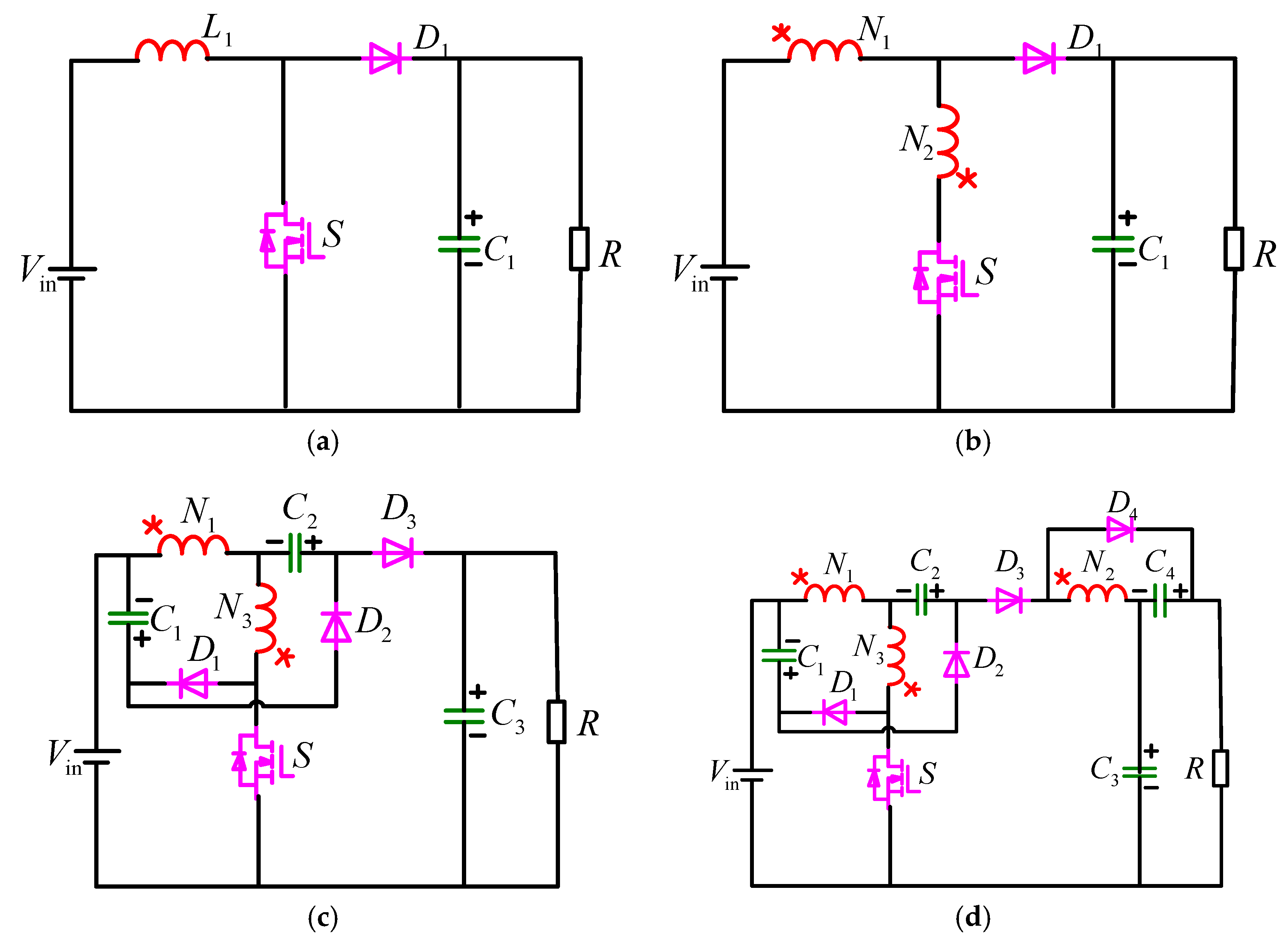
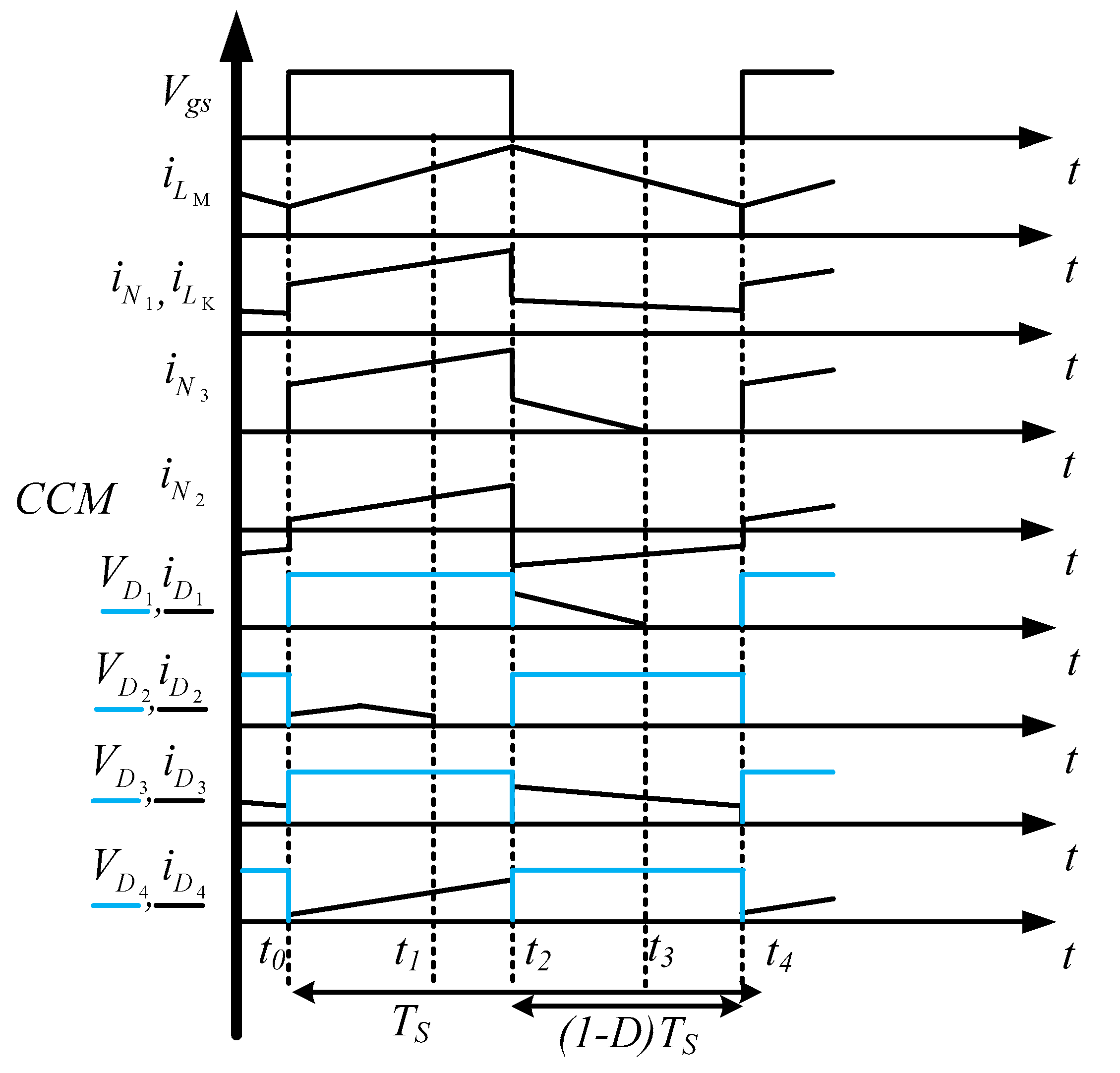


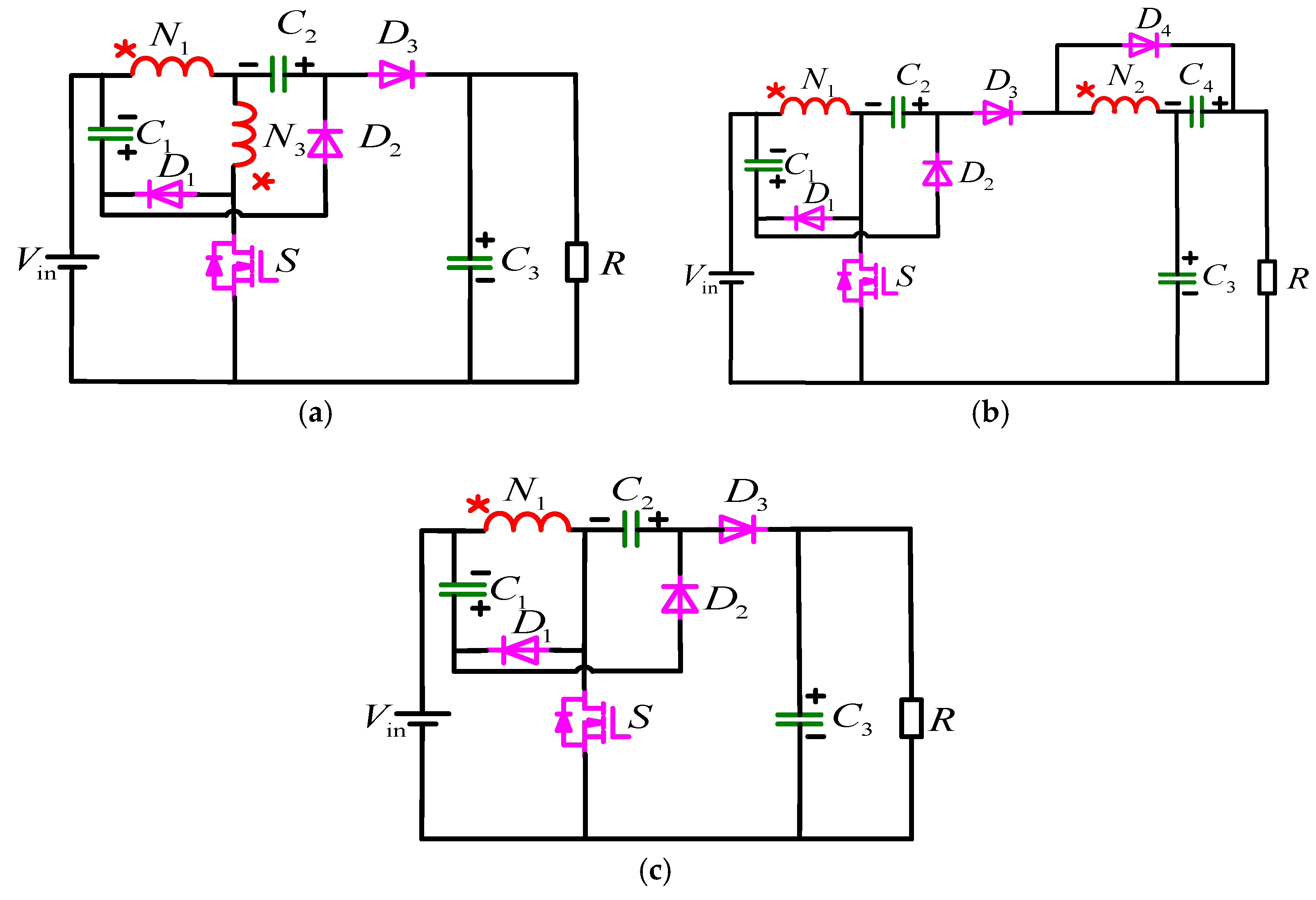
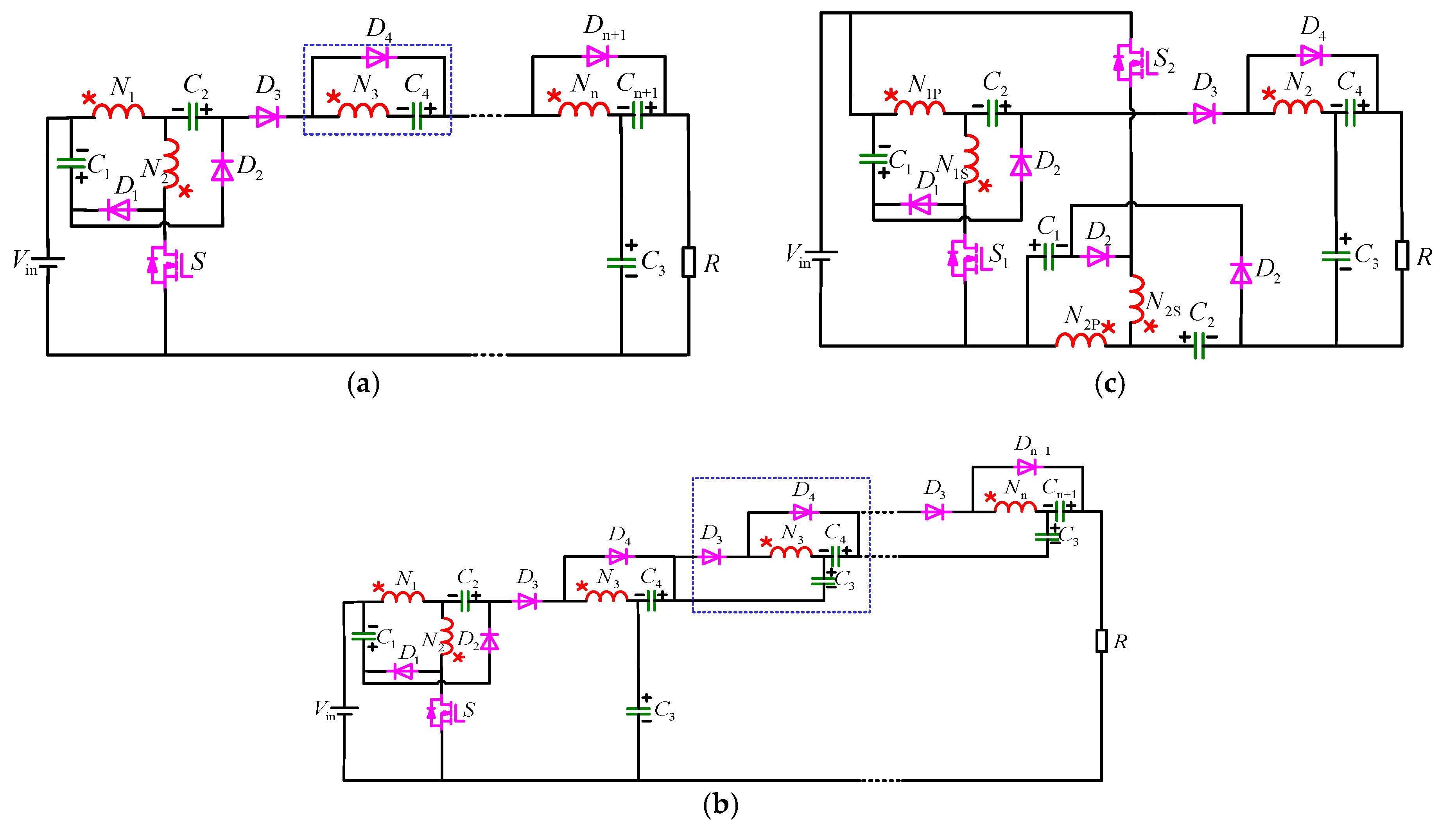
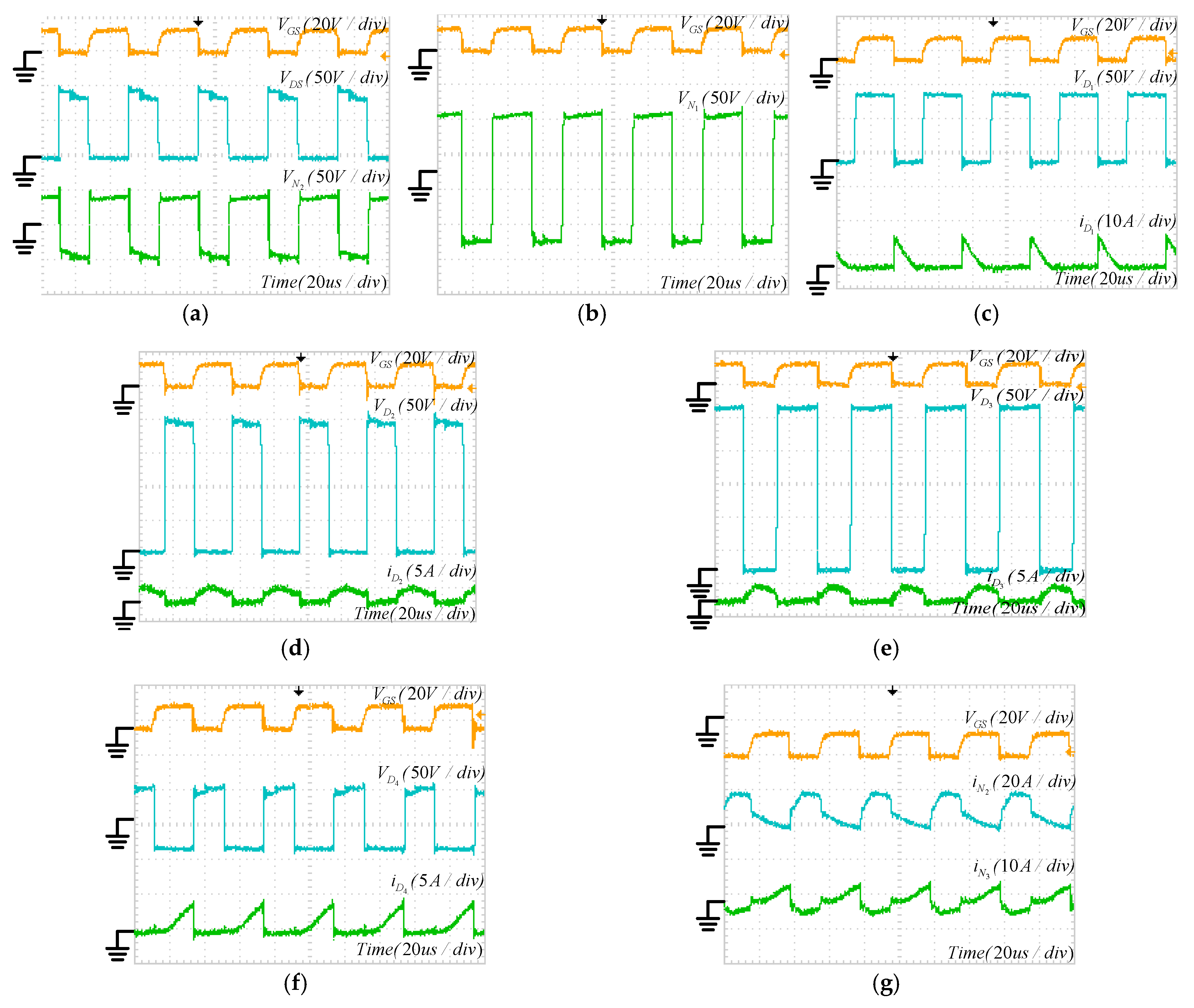
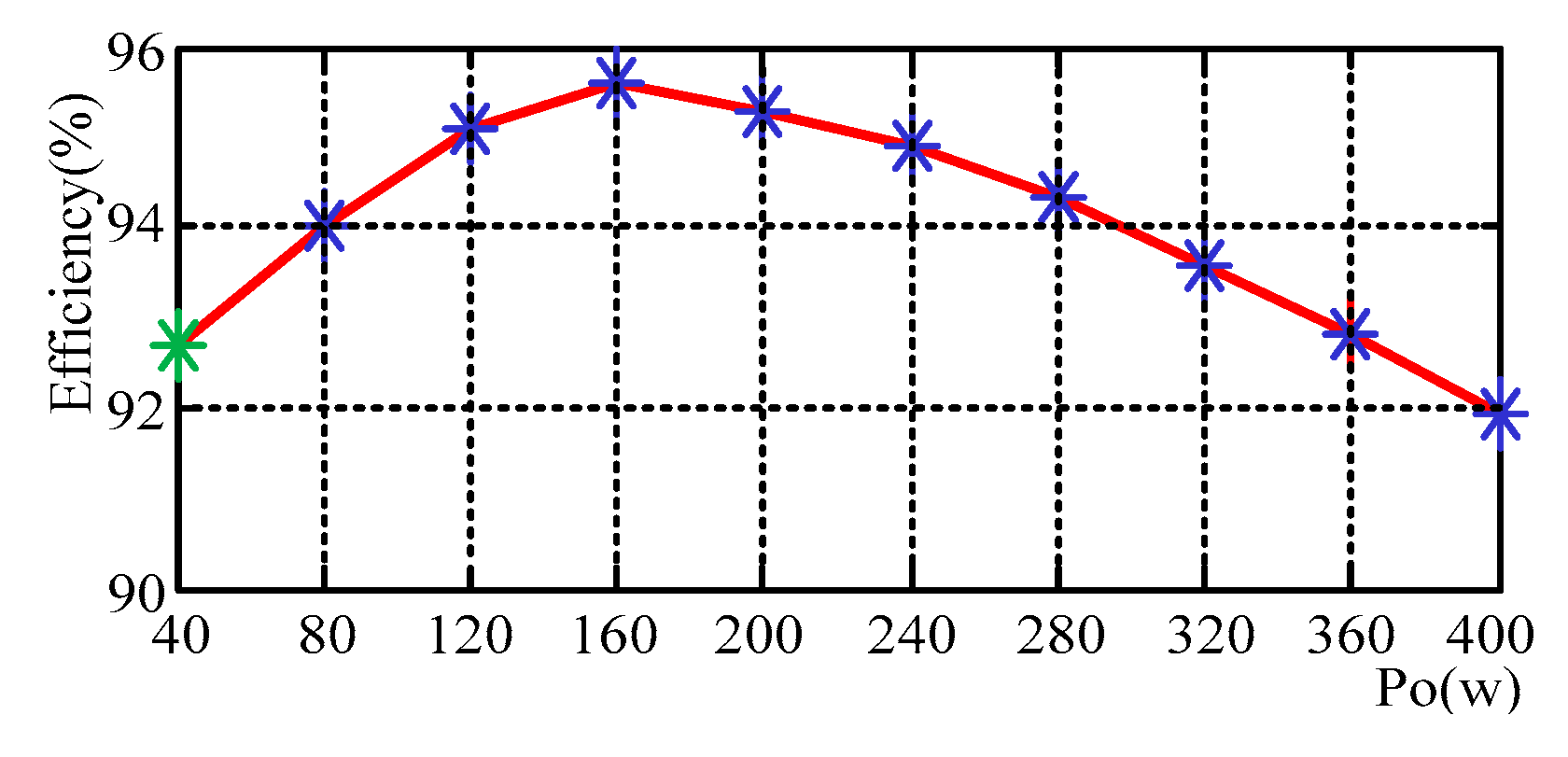
| Diode Number | Capacitor Number | Winding Number | Voltage Gain | Converter |
|---|---|---|---|---|
| n + 1 | n + 1 | n | Figure 6a | |
| 2n − 2 | 2n − 2 | n | Figure 6b | |
| 6 | 6 | 5 | Figure 6c |
| Specifications | Value |
|---|---|
| Input voltage Vin | 40 V |
| Output voltage V0 | 380 V |
| Rated power P0 | 400 W |
| Switching frequency fs | 50 kHz |
| MOSFET Switches S | IRFP4668 |
| Diodes D0, D1, D2, D3 | MUR460 |
| Capacitor C3 | 470 μF, 0.1 μF |
| Capacitor C1, C2, C4 | 10 μF |
| Coupled inductors core | Core-EE55 |
| Turn ratios | N1:N2:N3 = 30:16:16 |
| Winding value | N1 = 542 μH, N2 = 149.5 μH, N3 = 149.5 μH |
© 2018 by the authors. Licensee MDPI, Basel, Switzerland. This article is an open access article distributed under the terms and conditions of the Creative Commons Attribution (CC BY) license (http://creativecommons.org/licenses/by/4.0/).
Share and Cite
Gao, Y.; Liu, H.; Ai, J. Novel High Step-Up DC–DC Converter with Three-Winding-Coupled-Inductors and Its Derivatives for a Distributed Generation System. Energies 2018, 11, 3428. https://doi.org/10.3390/en11123428
Gao Y, Liu H, Ai J. Novel High Step-Up DC–DC Converter with Three-Winding-Coupled-Inductors and Its Derivatives for a Distributed Generation System. Energies. 2018; 11(12):3428. https://doi.org/10.3390/en11123428
Chicago/Turabian StyleGao, Yanying, Hongchen Liu, and Jian Ai. 2018. "Novel High Step-Up DC–DC Converter with Three-Winding-Coupled-Inductors and Its Derivatives for a Distributed Generation System" Energies 11, no. 12: 3428. https://doi.org/10.3390/en11123428
APA StyleGao, Y., Liu, H., & Ai, J. (2018). Novel High Step-Up DC–DC Converter with Three-Winding-Coupled-Inductors and Its Derivatives for a Distributed Generation System. Energies, 11(12), 3428. https://doi.org/10.3390/en11123428






